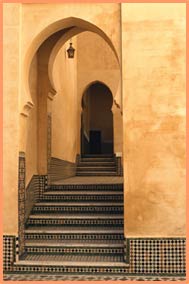History |
Cristel |
Tafraout
people
and their ways
The
Berber way
The people living in Tafraout and its surroundings all belong to the Ammeln Berber tribe- a name also given to the lush green valley just North of the city. The Ammeln people are known for their commercial saviness and business sense: they own small convenience stores all across Morocco (the local "hanut"). When an Ammeln man has saved enough money through this business venture, he usually returns to the Tafraout region and restores his family home. One of these restored Berber homes is open to the public, thanks to the courageous effort of a blind man and his two sons- who, since 1985 have been guiding people through the ways and manners of their people. I'll try my best to replicate the tour....
The
living quarters are well preserved- and give a small glimpse of life within
the heavy walls. But what is a Moroccan living room or kitchen without
any life or animation?
Perhaps,
if enough of you visit, he will be convinced to put on live performances
in his newly famous home. A see and tell show, replete with couscous cookers,
tea ceremonies and quarreling in-laws. In the meantime, each of us if
left with his or her imagination...
To visit this home, go 7 km North of Tafraout to the village of Oumesnat- then follow the signs to the "Maison Berbere".
The people living in Tafraout and its surroundings all belong to the Ammeln Berber tribe- a name also given to the lush green valley just North of the city. The Ammeln people are known for their commercial saviness and business sense: they own small convenience stores all across Morocco (the local "hanut"). When an Ammeln man has saved enough money through this business venture, he usually returns to the Tafraout region and restores his family home. One of these restored Berber homes is open to the public, thanks to the courageous effort of a blind man and his two sons- who, since 1985 have been guiding people through the ways and manners of their people. I'll try my best to replicate the tour....
| The
Ammelns live in square shaped homes, tucked in the flank of steep
hills, no far from the river flowing below. A lush Oasis on the
river banks provides farm land, a rarity in this draught stricken
region. The houses have thick walls, to keep the heat in during tough winters and out during the blazing summers. Windows are sparse for the same reasons- the main light inlet usually being near the kitchen, for cooking and ventilation purposes. All members of a family live together in one house. The space is divided amongst the couples, each appropriating one of the 4 corridors surrounding the kitchen. On the lowest level, small stables provide shelter for cows and other animals. |
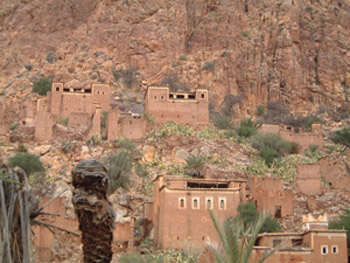 |
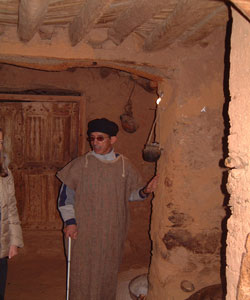 |
Our
guide is an elderly Berber, whose mastery of French equals his mastery
of space- he flows through the tricky grammatical nuances of the
Napoleonic language with much the same ease as he floats through
his house (with little but a cane to guide him). This house has been in his family for generations. A few years ago he moved to the new house (closer to the main road going to the Tafraout) and decided to renovate this older one, and turn it into a Museum. At first, only the most adventurous tourists made it to his home. But today, there are plenty of curious travelers. I can only imagine the number of times he has told this story- and yet, it seems to have lost none of its charm or intensity... Behind him, the door to the stables. Above him, the palm tree beams and leaves with which they build and insulate their homes. Before leading us upstairs, to the family quarters, he shows us how to press the Argan seed for oil, and how to crush barley into flour. Both necessitate heavy granite utensils: |
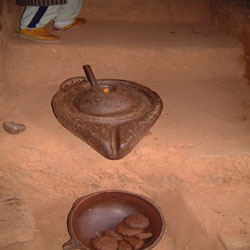 |
<-- The Argan seed is placed at the heart of the press, and the small disk is rotated on the bigger one using the handle. It takes 3 days of a "woman's work" to make one liter of oil. | 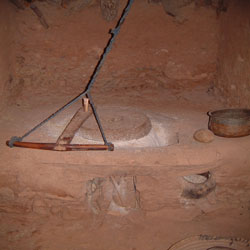 |
| Wheat seeds are placed in the small hole at the heart of the granite disk, which rotates thanks to the handle and lever. A flowery substance flows to the sides, and is later sifted. --> |
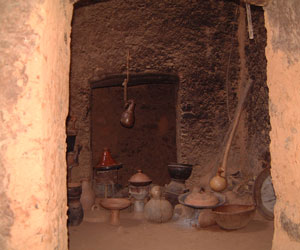 |
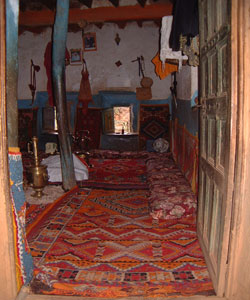 |
To visit this home, go 7 km North of Tafraout to the village of Oumesnat- then follow the signs to the "Maison Berbere".
